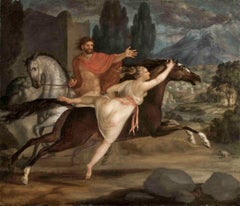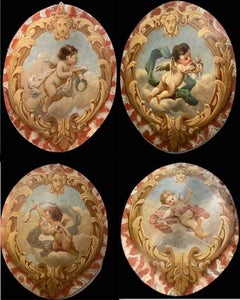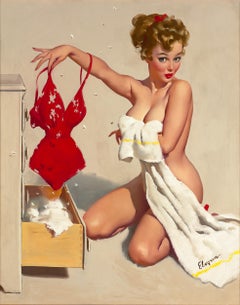Johann Heinrich Wilhelm Tischbein Art
German, 1751-1829
Tischein father, Johann Conrad, was the carpenter of the convent in Haina and his uncle-who was his first teacher-was an artist in Hamburg. From 1772 to 1773 he travelled in Holland studying the Old Masters and after 1777 he worked as a portrait painter in Berlin and became a member of the Masonic Lodge.
He moved to Rome in 1779 and continued his studies-thanks to a stipend from the Kunsthochschule Kassel-progressing from the Rococo of his early works to the Classicism of his maturity ones. After a turbolent time that he spent in Zurich, he returned in Rome with a grant from Duke Ernest II, obtained upon the recommendation of his friend Johann Wolfgang von Goethe, with whom travelled in Naples in 1787. During his last ten years there, he was director of the Accademia di Belle Arti di Napoli. He left following the French occupation, when the anti-royalist Parthenopean Republic was established.
After 1808, he worked for Grand Duke Peter I and he lived in Eutin untill he died.(Biography provided by GALLERIA MARLETTA)
1
to
2
2
1
1
Overall Height
to
Overall Width
to
1
2
2
1
1
1
2
2
2
6,827
3,109
2,517
1,217
1
1
1
1
1
Artist: Johann Heinrich Wilhelm Tischbein
Friend of Goethe - Drawing By J. H. Wilhelm Tischbein- 1781
By Johann Heinrich Wilhelm Tischbein
Located in Roma, IT
Friend of Goethe is a Pencil Drawing realized by Johann Heinrich Wilhelm Tischbein in 1781.
The artwork is in good condition, on a grey paper, included a cardboard passpartout (35x5...
Category
18th Century Modern Johann Heinrich Wilhelm Tischbein Art
Materials
Pencil
German Tischbein Figurative Nude Mithology Painting 18th centuryoil canvas
By Johann Heinrich Wilhelm Tischbein
Located in Florence, IT
The painting–thin oil on canvas, in some parts unfinished−can be referred to the hand of the German painter Johann Heinrich Wilhelm Tischbein. It should be dated in the years between...
Category
1780s Other Art Style Johann Heinrich Wilhelm Tischbein Art
Materials
Canvas, Oil
Related Items
Four Oval Shaped 19' Century Allegorical Paintings
Located in Rome, IT
Set of four delicious putto figures , oval shape oil on canvas .
Fine tromple oeil painted frame .
Very good original condition.
Category
19th Century Johann Heinrich Wilhelm Tischbein Art
Materials
Canvas, Oil
Partial Coverage By Gil Elvgren
By Gil Elvgren
Located in New Orleans, LA
Gil Elvgren
1914-1980 American
Partial Coverage
Signed “Elvgren” (lower right)
Oil on canvas
The iconic illustrations of Gil Elvgren have become an irreplaceable facet of the American artistic landscape. Flirtatious beauties in light-hearted situations were the dominant subject matter for this intuitive artist, whose eloquent brush strokes dutifully captured the innocent sensuality of the mischievous girl next door. Partial Coverage, originally published in the 1956 Brown & Bigelow calendar, epitomizes the coquettish spirit of his beauties, whose nostalgic glamor give us a glimpse into a simpler time in American history.
Elvgren is considered to be the greatest American pin-up and glamor artist. The majority of his work was done for the famed Brown & Bigelow, though at various points in his career he also worked for magazines such as The Saturday Evening Post and Good Housekeeping, as well as large corporations including Sealy Mattresses, General Electric and Coca-Cola.
Born in St. Paul, Minnesota, Elvgren began his artistic education at the Minneapolis Art Institute, and later the American Academy of Art. His first job upon graduation was at the Chicago advertising firm of Stevens and Gross, working directly under Haddon Sundblom, famous for his Coca-Cola Santas. Elvgren would soon become his star pupil, contributing much to the Coca-Cola campaigns and eagerly learning techniques that he would carry into his famed pin-ups.
After completing several special commissions with rave reviews, Elvgreen began doing pin-up work in 1937 for the Louis F. Dow Calendar Company, the biggest retailer of calendars of its day. Almost overnight, the artist became one of the most respected and successful commercial artists of his generation. More commissions followed, and, along with his work for Dow, Elvgren found himself booked solid at least one year ahead of his output. It was in 1944 that Brown & Bigelow approached him with an offer for a staff position. From that point on, for the next 30 years, Elvgren enjoyed tremendous commercial success unlike any other American artist of his day.
Circa 1956
Canvas: 30 1/8“ high x 24 1/8” wide
Frame: 33 3/4“ high x 27 7/8” wide x 1 1/2“ deep
Literature:
Charles G. Martignette and Louis K...
Category
20th Century Johann Heinrich Wilhelm Tischbein Art
Materials
Canvas, Oil
British drawing of nude sleeping figures entwined by 20th Century artist Ayrton
By Michael Ayrton
Located in Petworth, West Sussex
Michael Ayrton (British, 1921 – 1975)
Sleeping figures
Inscribed, signed and dated ‘Michael Ayrton 5.11.66 / Sleeping figures II’ (lower right)
Pencil on paper
15 x 19.1/4 in. (38.2 ...
Category
20th Century Modern Johann Heinrich Wilhelm Tischbein Art
Materials
Paper, Pencil
H 15 in W 19.25 in D 1 in
Boston Abstract Expressionist Hyman Bloom Original Pencil Drawing Martin Sumers
By Hyman Bloom
Located in Surfside, FL
This is a unique artwork. This is an original Hyman Bloom drawing of fellow artist and his very good friend Martin Sumers.I believe this was drawn at the “variations of a theme” at Sumers gallery in NYC. The last two photos show a poster and a card from their shows. it is not included in this listing, it is just for provenance.
Provenance: Acquired from the Sumers estate collection.
Hyman Bloom (March 29, 1913 – August 26, 2009) was a Latvian-born American painter. His work was influenced by his Jewish heritage and Eastern religions as well as by artists including Altdorfer, Grünewald, Caravaggio, Rembrandt, Blake, Bresdin, James Ensor and Chaim Soutine. He first came to prominence when his work was included in the 1942 Museum of Modern Art exhibition "Americans 1942 -- 18 Artists from 9 States". MoMA purchased 2 paintings from the exhibition and Time magazine singled him out as a "striking discovery" in their exhibition review.
His work was selected for both the 1948 and 1950 Venice Biennale exhibitions and his 1954 retrospective traveled from Boston's Institute of Contemporary Art to the Albright Gallery and the de Young Museum before closing out at The Whitney Museum of American Art in 1955. In a 1954 interview with Yale art professor Bernard Chaet, Willem de Kooning indicated that he and Jackson Pollock both considered Bloom to be “America’s first abstract expressionist”, a label that Bloom would disavow. Starting in the mid 1950s his work began to shift more towards works on paper and he exclusively focused on drawing throughout the 1960s, returning to painting in 1971. He continued both drawing and painting until his death in 2009 at the age of 9
Hyman Bloom (né Melamed) was born into an orthodox Jewish family in the tiny Jewish village of Brunavišķi in what is now Latvia, then part of the Russian Empire
At a young age Bloom planned to become a rabbi, but his family could not find a suitable teacher. In the eighth grade he received a scholarship to a program for gifted high school students at the Museum of Fine Arts. He attended the Boston High School of Commerce, which was near the museum. He also took art classes at the West End Community Center, a settlement house. The classes were taught by Harold Zimmerman, a student at the School of the Museum of Fine Arts, who also taught the young Jack Levine at another settlement house in Roxbury. When Bloom was fifteen, he and Levine began studying with a well-known Harvard art professor, Denman Ross, who rented a studio for the purpose and paid the boys a weekly stipend to enable them to continue their studies rather than take jobs to support their families.
He took Bloom and Levine on a field trip to the Museum of Modern Art in New York, where Bloom was impressed by the work of Rouault and Soutine and began experimenting with their expressive painting styles.
In the 1930s Bloom worked sporadically for the Public Works of Art Project and the Federal Art Project (WPA), He shared a studio in the South End with Levine and another artist, Betty Chase. It was during this period that he developed a lifelong interest in Eastern philosophy and music, and in Theosophy.
He first received national attention in 1942 when thirteen of his paintings were included in the Museum of Modern Art (MoMA) exhibition Americans 1942: 18 Artists from 9 States, curated by Dorothy Miller. MoMA purchased two of his paintings from that exhibition, and he was featured in Time magazine. The titles of his paintings in the exhibition reflect some of his recurring themes. Two were titled The Synagogue, another, Jew with the Torah; Bloom was actually criticized by one reviewer for including "stereotypical" Jewish images. He also had two paintings titled The Christmas Tree, and another titled The Chandelier, both subjects he returned to repeatedly. Another, Skeleton (c. 1936), was followed by a series of cadaver paintings in the forties, and The Fish (c. 1936) was one of many paintings and drawings of fish he created over the course of his career.
Bloom was associated at first with the growing Abstract Expressionist movement. Willem de Kooning and Jackson Pollock, who first saw Bloom's work at the MoMA exhibition, considered Bloom "the first Abstract Expressionist artist in America." In 1950 he was chosen, along with the likes of de Kooning, Pollock, and Arshile Gorky, to represent the United States at the Venice Biennale. That same year Elaine de Kooning wrote about Bloom in ARTnews, noting that in paintings such as The Harpies, his work approached total abstraction: "the whole impact is carried in the boiling action of the pigment". In 1951 Thomas B. Hess reproduced Bloom's Archaeological Treasure in his first book, Abstract Painting: Background and American Phase, along with works by Picasso, Pollock, and others. Both de Kooning and Hess remarked on Bloom's expressive paint handling, a key characteristic of Abstract Expressionist painting.
As abstract expressionism dominated the American art world, Bloom became disenchanted with it, calling it "emotional catharsis, with no intellectual basis." In addition, instead of moving to New York to pursue his career, he opted to stay in Boston. As a result he fell out of favor with critics and never achieved the kind of fame that Pollock and others did. He disliked self-promotion and never placed much value on critical acclaim.
Many of Bloom's paintings feature rabbis, usually holding the Torah. According to Bloom, his intentions were more artistic than religious. He began questioning his Jewish faith early in life, and painted rabbis, he claimed, because that was what he knew. Over the course of his career he produced dozens of paintings of rabbis...
Category
20th Century Modern Johann Heinrich Wilhelm Tischbein Art
Materials
Paper, Pencil
Nude Mermaid Under Sea, German Outsider Folk Art OIl Painting
By Hajo Malek
Located in Surfside, FL
Fantasy Nude Mermaid
German outsider Naive artist born in 1922. has exhibited in Germany in 1969 worked in painting, gouache and linocuts. Expressionist Folk Art style.
Art brut, pr...
Category
1990s Outsider Art Johann Heinrich Wilhelm Tischbein Art
Materials
Canvas, Oil
Chita Rivera BYE BYE BIRDIE Original 1960 Broadway Costume Drawing Tony Awards
Located in New York, NY
Chita Rivera BYE BYE BIRDIE Original 1960 Broadway Costume Drawing Tony Awards
Miles White (1915 – 2000)
ChITA RIVERA in BYE BYE BIRDIE
11 x 8 inches
M...
Category
1960s American Modern Johann Heinrich Wilhelm Tischbein Art
Materials
Watercolor, Gouache, Pencil
Hotelscene with Ghost- 21st Century Contemporary Painting of a game with nude
Located in Nuenen, Noord Brabant
Ferenc Erdok
Hotelscene with Ghost
240 x 185 cm
Oil on canvas
A unique work where a classical theme as a male nude and todays game world come together....
Category
2010s Contemporary Johann Heinrich Wilhelm Tischbein Art
Materials
Cotton Canvas, Oil
Free Shipping
H 240 in W 185 in D 3 in
"Banksia" Oil Painting 27" x 39" inch by Sasha Sokolova
Located in Culver City, CA
"Banksia" Oil Painting 27" x 39" inch by Sasha Sokolova
Life Still
"I produced this series in 2020 while mostly in lockdown due to the Coronavirus. I a...
Category
21st Century and Contemporary Realist Johann Heinrich Wilhelm Tischbein Art
Materials
Oil, Canvas
Male Torso
By John Koch
Located in London, GB
Pencil, coloured pencil and chalk on paper, titled (lower left), signed (lower right), 31cm x 46cm, (51cm x 68cm framed).
John Koch was an American painter and teacher, and an impo...
Category
1950s American Modern Johann Heinrich Wilhelm Tischbein Art
Materials
Paper, Chalk, Pencil, Color Pencil
Orientale
By Henri Fantin-Latour
Located in New York, NY
Signed, lower right: Fantin
Provenance:
Gustave Tempelaere (1840–1904), Paris; possibly by descent to his son:
Julien Tempelaere (1876–1961) and with F. & J. Tempelaere, Paris, prob...
Category
1890s Romantic Johann Heinrich Wilhelm Tischbein Art
Materials
Canvas, Paper, Oil
French Modern Drawing by Jean Hélion - Veil Homme
By Jean Hélion
Located in Paris, IDF
Veil Homme
1947
drawing
26,9 x 21 cm
Registered on the catalogue raisonné with inventory number : N°0252 cat. B
sold without frame
about Jean Hélion (April 21, 1904 – October 27, 19...
Category
1960s Modern Johann Heinrich Wilhelm Tischbein Art
Materials
Pencil, Paper
Venus Retrieved from the Hands of Death, Surrealist, Nudes, 1959, Oil on Canvas
By Leon Kelly
Located in Doylestown, PA
"Venus Retrieved from the Hands of Death" by Philadelphia born modernist painter Leon Kelly, is a fantasy nude group scene of one female and two male figures. The 49" x 36" oil on ca...
Category
1950s Surrealist Johann Heinrich Wilhelm Tischbein Art
Materials
Canvas, Oil
Free Shipping
H 54 in W 41 in D 2 in
Johann Heinrich Wilhelm Tischbein art for sale on 1stDibs.
Find a wide variety of authentic Johann Heinrich Wilhelm Tischbein art available for sale on 1stDibs. You can also browse by medium to find art by Johann Heinrich Wilhelm Tischbein in canvas, fabric, oil paint and more. Much of the original work by this artist or collective was created during the 18th century and is mostly associated with the modern style. Not every interior allows for large Johann Heinrich Wilhelm Tischbein art, so small editions measuring 14 inches across are available. Customers who are interested in this artist might also find the work of Buscot, Bruno Conte, and Wasim Kapoor. Johann Heinrich Wilhelm Tischbein art prices can differ depending upon medium, time period and other attributes. On 1stDibs, the price for these items starts at $396 and tops out at $396, while the average work can sell for $396.



